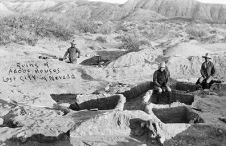A Story of Encounters: Troubled Encounters
Throughout the United States, many early encounters between native tribes and non-natives were tense—even hostile—and the area that became Nevada was no exception.
The westward expansion of the United States was fully underway by the 1840s, with the establishment of emigrant trails to Oregon and California. Beginning in the mid-nineteenth century, a series of unexpected events brought rapid change to the Great Basin. The Gold Rush of 1849 sent thousands of fortune-seekers through the region to the Sierra foothills, and in 1859, the discovery of the Comstock Lode shifted attention to “Washoe,” an early name for northern Nevada’s mining districts.
The philosophy of “Manifest Destiny” encouraged Euro-Americans to bring what they considered civilization to the western lands and the people who lived there. With the growth of mining, ranching, and railroad operations throughout the state, many native tribes lost control of key resources and were forced to adapt to a new environment controlled largely by others. Early periods of sporadic hostility settled into a climate of sometimes begrudging tolerance on both sides.
In the decades after Nevada statehood, tribal members gained some official reservations of land, but remained subject to extensive discrimination and prejudice. Government-run schools focused on assimilating native children into mainstream American culture. And Nevada Indians who found work in the state’s new industries mostly held jobs of lower pay and status. Still, many non-natives worked to secure rights and opportunities for tribes and their members.
Article Locations
Related Articles
Further Reading
None at this time.



